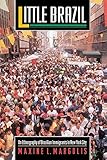Little Brazil : An Ethnography of Brazilian Immigrants in New York City / Maxine L. Margolis.
Material type: TextPublisher: Princeton, NJ : Princeton University Press, [2021]Copyright date: ©1994Description: 1 online resource (360 p.) : 16 halftones 3 mapsContent type:
TextPublisher: Princeton, NJ : Princeton University Press, [2021]Copyright date: ©1994Description: 1 online resource (360 p.) : 16 halftones 3 mapsContent type: - 9781400851751
- Brazilian Americans -- New York (State) -- New York -- Social life and customs
- SOCIAL SCIENCE / Anthropology / General
- African-Americans
- Alves, Castro
- Baptists
- Botelhos (Brazil)
- Brazilian Lions Club
- Buenos Aires
- California
- Dominican Republic
- Fort Lauderdale (Fla.)
- French language
- Grasmuck, Sherri
- Hispanics
- Jackson Heights (N.Y.)
- Kearney (N.J.)
- Koch, Edward
- Lindenhurst (NJ.)
- Lula (Luis Inacio da Silva)
- New York Magazine
- Pentecostal church
- Pessar, Patricia
- Portugal
- Protestants
- Resplendor (Brazil)
- Spiritists
- São Paulo
- Times Square
- Veja
- Whitman (Mass.)
- barmaids
- book distributors
- car service companies
- concerts
- domestic division of labor
- driver’s licenses
- entrepreneurs
- factory work
- flier distributors
- gender hierarchy
- hairdressers
- immigration inspection
- lumberjacks
- methodology, research
- musicians
- occupational mobility, of immigrants
- parking lot attendants
- purchasing power index
- racism
- restaurant work
- semiprecious stones
- social security cards
- undocumented immigration
- work documentation
- 974.7/1004698 20
- F128.9.B68 M37 1994
- online - DeGruyter
| Item type | Current library | Call number | URL | Status | Notes | Barcode | |
|---|---|---|---|---|---|---|---|
 eBook
eBook
|
Biblioteca "Angelicum" Pont. Univ. S.Tommaso d'Aquino Nuvola online | online - DeGruyter (Browse shelf(Opens below)) | Online access | Not for loan (Accesso limitato) | Accesso per gli utenti autorizzati / Access for authorized users | (dgr)9781400851751 |
Frontmatter -- CONTENTS -- List of Illustrations -- List of Tables -- Preface -- LITTLE BRAZIL -- Chapter 1. The New Voyagers -- Chapter 2. Bye-Bye, Brazil -- Chapter 3. First Days -- Chapter 4. Who Are They? -- Chapter 5. Making a Living -- Chapter 6. From Mistress to Servant -- Chapter 7. Shoe Shine "Boys" and Go-Go "Girls" -- Chapter 8. Life and Leisure in the Big Apple -- Chapter 9. Little Brazil: Is It a Community? -- Chapter 10. Class Pictures -- Chapter 11. An Invisible Minority -- Chapter 12. Sojourner or Immigrant? -- Notes -- Glossary of Portuguese and Brazilian-American Terms -- References -- Index
restricted access online access with authorization star
http://purl.org/coar/access_right/c_16ec
Walking west on 46th Street in Manhattan, just three blocks from Rockefeller Center, one passes Brazilian restaurants, the office of New York's Brazilian newspaper, a Brazilian travel agency, a business that sends remittances and wires flowers to Brazil, and a store that sells Brazilian food products, magazines, newspapers, videos, and tapes. These businesses are the tip of an ethnic iceberg, an unseen minority estimated to number some 80,000 to 100,000 Brazilians in the New York metropolitan area alone. Despite their numbers, the lives of these people remain largely hidden to scholars and the public alike. Now Maxine L. Margolis remedies this neglect with a fascinating and accessible account of the lives of New York's Brazilians.Showing that these immigrants belie American stereotypes, Margolis reveals that they are largely from the middle strata of Brazilian society: many, in fact, have university educations. Not driven by dire poverty or political repression, they are fleeing from chaotic economic conditions that prevent them from maintaining amiddle-class standard of living in Brazil. But despite their class origin and education, with little English and no work papers, many are forced to take menial jobs after their arrival in the United States. Little Brazil is not an insentient statistical portrait of this population writ large, but a nuanced account that captures what it is like to be a new immigrant in this most cosmopolitan of world cities.
Mode of access: Internet via World Wide Web.
In English.
Description based on online resource; title from PDF title page (publisher's Web site, viewed 01. Dez 2022)


